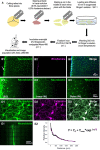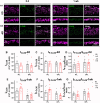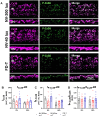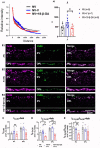The Role of Retinal Connexins Cx36 and Horizontal Cell Coupling in Emmetropization in Guinea Pigs
- PMID: 34283211
- PMCID: PMC8300059
- DOI: 10.1167/iovs.62.9.27
The Role of Retinal Connexins Cx36 and Horizontal Cell Coupling in Emmetropization in Guinea Pigs
Abstract
Purpose: The purpose of this study was to determine whether retinal gap junctions (GJs) via connexin 36 (Cx36, mediating coupling of many retinal cell types) and horizontal cell (HC-HC) coupling, are involved in emmetropization.
Methods: Guinea pigs (3 weeks old) were monocularly form deprived (FD) or raised without FD (in normal visual [NV] environment) for 2 days or 4 weeks; alternatively, they wore a -4 D lens (hyperopic defocus [HD]) or 0 D lens for 2 days or 1 week. FD and NV eyes received daily subconjunctival injections of a nonspecific GJ-uncoupling agent, 18-β-Glycyrrhetinic Acid (18-β-GA). The amounts of total Cx36 and of phosphorylated Cx36 (P-Cx36; activated state that increases cell-cell coupling), in the inner and outer plexiform layers (IPLs and OPLs), were evaluated by quantitative immunofluorescence (IF), and HC-HC coupling was evaluated by cut-loading with neurobiotin.
Results: FD per se (excluding effect of light-attenuation) increased HC-HC coupling in OPL, whereas HD did not affect it. HD for 2 days or 1 week had no significant effect on retinal content of Cx36 or P-Cx36. FD for 4 weeks decreased the total amounts of Cx36 and P-Cx36, and the P-Cx36/Cx36 ratio, in the IPL. Subconjunctival 18-β-GA induced myopia in NV eyes and increased the myopic shifts in FD eyes, while reducing the amounts of Cx36 and P-Cx36 in both the IPL and OPL.
Conclusions: These results suggest that cell-cell coupling via GJs containing Cx36 (particularly those in the IPL) plays a role in emmetropization and form deprivation myopia (FDM) in mammals. Although both FD and 18-β-GA induced myopia, they had opposite effects on HC-HC coupling. These findings suggest that HC-HC coupling in the OPL might not play a significant role in emmetropization and myopia development.
Conflict of interest statement
Disclosure:
Figures








References
-
- Holden BA, Fricke TR, Wilson DA, et al. .. Global prevalence of myopia and high myopia and temporal trends from 2000 through 2050. Ophthalmology. 2016; 123: 1036–1042. - PubMed
-
- Zhou X, Lu F, Xie R, et al. .. Recovery from axial myopia induced by a monocularly deprived facemask in adolescent (7-week-old) guinea pigs. Vision Res . 2007; 47: 1103–1111. - PubMed
-
- Zheng H, Tse DY, Tang X, To C, Lam TC.. The interactions between bright light and competing defocus during emmetropization in chicks. Invest Ophthalmol Vis Sci . 2018; 59: 2932–2943. - PubMed
-
- Wässle H. Parallel processing in the mammalian retina. Nat Rev Neurosci . 2004; 5: 747–757. - PubMed
Publication types
MeSH terms
Substances
LinkOut - more resources
Full Text Sources
Miscellaneous

